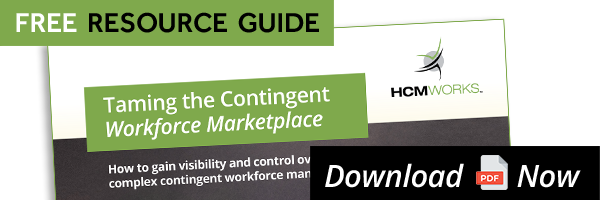Your 5 biggest workforce challenges,
and what you can do about them!
The contingent or non-permanent workforce provides your organization with many significant benefits. But engaging contingent workers also comes with some potentially costly consequences. Here are five of the toughest challenges you face.
EXECUTIVE SUMMARYROGUE HIRING RISKY BEHAVIOR REQ TO CHECK SET UP AND ROLL OUT
|
Read The Full Story
Although this new workforce vision comes with a host of advantages, it also comes with some serious challenges that many organizations are ill-prepared to face.
Workforce challenge #1 –
Lack of visibility on Non-Permanent Workforce spend and headcount
Perhaps the greatest challenge faced by most organizations using various forms of contingent workers is proper accounting of these resources. Why? Because these resources are often retained directly by hiring managers: rogue hiring and spend that escapes traditional accounting and control.
The result is a general lack of visibility on contingent workforce headcount and spend. You can’t manage what you can’t measure, so this lack of visibility can lead to organizational inefficiencies, higher workforce costs and poor decision-making based on incorrect assumptions as to the true makeup of the organization’s workforce.
Workforce challenge #2 –
Limited cost management
A corollary of challenge # 1 is that a fragmented and disparate hiring process generally leads to paying too much for the resources and talent you retain.
Better contingent workers accounting can help you clearly identify your total contingent spend and reduce the number of staffing vendors you deal with. By consolidating your spend amongst a handful of best-of-breed staffing companies, you can more effectively negotiate rate cards, margins and volume discounts.
Creating healthy competition within this handful of quality vendors will help drive down costs and simplify the management of the procure-to-pay process.
Workforce challenge #3 –
Poor access to quality talent and high turnover rates
A disparate hiring process also leads to greater difficulty in gaining access to talent and a longer time to fill.
According to the Wall Street Journal, it takes an average of 25 days to fill a position, as procurement typically sifts through 250+ resumes of mostly poor quality candidates in the hopes of finding one or two quality resources that fit the bill. The more specialized the worker – in engineering, nursing and IT, for example – the more time it takes to fill the position.
Poor talent quality has the added consequence of extremely high turnover rates: on average, as much as 359% according to the American Staffing Association. So after spending too much time filling a position, you have the extra challenge of managing an underperforming employee.
Workforce challenge #4 –
Exposure to misclassification and co-employment risks
Poor accounting and management of your contingent workers can have a very real downside that can far outweigh the value of using contingent workers. In fact, the consequences can be devastating to your business.
Litigation by the IRS is on the rise. On the surface, it appears to be a way for the government to protect the rights of workers who have been cheated out of benefits, overtime pay, etc. But deep down, it’s a way to protect its tax base against the rising on-demand economy, made up largely of independent contractors.
At the same time, class action lawsuits by groups of workers who feel they have been improperly classified as independent contractors (think FedEx and Uber drivers) are becoming increasingly commonplace and can potentially threaten the very survival of your business.
By some estimates, the cost for a single misclassified worker can reach $80,000. With contingent workers representing up to 35% of the workforce in the majority of organizations, the potential costs can reach into the millions.
Workforce challenge #5 –
Inefficiencies run rampant and errors add up fast
Not only does the time to fill stretch out far beyond the acceptable norm (see challenge #3), but the entire procure-to-pay process, from “req to check” as the expression goes, becomes bogged down and convoluted because of too many fingers in the HR pie.
Rogue recruitment and spend is by definition highly inefficient since hiring managers are generally venturing into unfamiliar territory. But above all, poorly managed contingent workforce accounting is prone to costly time sheet data entry and reporting errors, on top of a slow and cumbersome recruitment process. It’s marketplace chaos that your organization can ill afford.
What can you do to rise up to these challenges?
Set up a structured and comprehensive Contingent Workforce Management program that will ensure your contingent workers accounting is accurate. Be sure to include the necessary policies, processes and infrastructure needed to consolidate and standardize the hiring process, streamline staffing-vendor relations, drive out errors and ensure fair market rates and markups.
Pay particular attention to executive buy-in and change management. With C-suite backing and a solid adoption model, you can ensure that your contingent workers accounting program will gain traction as you deploy it across the organization.
Don’t know where to start? Get outside help from a Managed Service Provider who has experience in your industry, as well as the right tools, processes and people to implement and deploy as effectively as possible.



